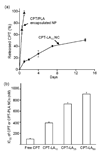Controlled synthesis of camptothecin-polylactide conjugates and nanoconjugates
- PMID: 20000458
- PMCID: PMC2809133
- DOI: 10.1021/bc900356g
Controlled synthesis of camptothecin-polylactide conjugates and nanoconjugates
Abstract
We report here a unique method of formulating camptothecin-polylactide (CPT-PLA) conjugate nanoparticles, termed nanoconjugates (NCs), through CPT/(BDI)ZnN(TMS)(2) [(BDI) = 2-((2,6-diisopropylphenyl)amido)-4-((2,6-bisalkyl)-imino)-2-pentene] mediated polymerization of lactide (LA) followed by nanoprecipitation. When CPT was used as the initiator to polymerize LA in the presence of (BDI)ZnN(TMS)(2), the polymerization was completed within hours with nearly 100% CPT loading efficiency and 100% LA conversion. CPT loading as high as 19.5% can be achieved for the CPT-polylactide (CPT-PLA) conjugate prepared at a LA/CPT ratio of 10. The steric bulk of the chelating ligands and the type of metals used had a dramatic effect on the initiation of the LA polymerization and the tendency of the ring-opening of the CPT lactone. The CPT/(BDI)ZnN(TMS)(2)-mediated LA polymerization yielded CPT-PLA conjugates with well-controlled molecular weights and narrow molecular weight distributions (1.02-1.18). The nanoprecipitation of CPT-PLA led to the formation of NCs around 100 nm in size with narrow particle size distributions. Sustained release of CPT from CPT-PLA NCs was achieved without burst release. CPT-PLA NCs were toxic to PC-3 cells with tunable IC(50) possible by adjusting the drug loading of the CPT-PLA NCs.
Figures








Similar articles
-
Ring-opening polymerization-mediated controlled formulation of polylactide-drug nanoparticles.J Am Chem Soc. 2009 Apr 8;131(13):4744-54. doi: 10.1021/ja8084675. J Am Chem Soc. 2009. PMID: 19281160
-
The formulation of aptamer-coated paclitaxel-polylactide nanoconjugates and their targeting to cancer cells.Biomaterials. 2010 Apr;31(11):3043-53. doi: 10.1016/j.biomaterials.2010.01.009. Epub 2010 Feb 1. Biomaterials. 2010. PMID: 20122727 Free PMC article.
-
Effect of structural factors on release profiles of camptothecin from block copolymer conjugates with high load of drug.Int J Pharm. 2018 Mar 1;538(1-2):231-242. doi: 10.1016/j.ijpharm.2018.01.022. Epub 2018 Jan 16. Int J Pharm. 2018. PMID: 29341920
-
Polylactide nanoparticles containing stably incorporated cyanine dyes for in vitro and in vivo imaging applications.Microsc Res Tech. 2010 Sep;73(9):901-9. doi: 10.1002/jemt.20824. Microsc Res Tech. 2010. PMID: 20146347
-
Drug-initiated ring-opening polymerization of O-carboxyanhydrides for the preparation of anticancer drug-poly(O-carboxyanhydride) nanoconjugates.Biomacromolecules. 2013 Mar 11;14(3):920-9. doi: 10.1021/bm301999c. Epub 2013 Feb 27. Biomacromolecules. 2013. PMID: 23445497 Free PMC article.
Cited by
-
Degradable polymer prodrugs with adjustable activity from drug-initiated radical ring-opening copolymerization.Chem Sci. 2018 Sep 13;9(43):8291-8306. doi: 10.1039/c8sc02256a. eCollection 2018 Nov 21. Chem Sci. 2018. PMID: 30542578 Free PMC article.
-
Synthesis of water-soluble camptothecin-polyoxetane conjugates via click chemistry.Mol Pharm. 2012 Nov 5;9(11):3403-8. doi: 10.1021/mp3005066. Epub 2012 Oct 23. Mol Pharm. 2012. PMID: 23051100 Free PMC article.
-
Magnesium-Catalyzed Dye-Embedded Polylactide Nanoparticles for the Effective Killing of Highly Metastatic B16F10 Melanoma Cells.ACS Omega. 2024 Mar 25;9(13):14860-14866. doi: 10.1021/acsomega.3c07898. eCollection 2024 Apr 2. ACS Omega. 2024. PMID: 38585097 Free PMC article.
-
Drug-Initiated Synthesis of Polymer Prodrugs: Combining Simplicity and Efficacy in Drug Delivery.Chem Mater. 2016 Mar 22;28(6):1591-1606. doi: 10.1021/acs.chemmater.5b04281. Epub 2016 Feb 21. Chem Mater. 2016. PMID: 27041820 Free PMC article. Review.
-
Degradation of Polymer-Drug Conjugate Nanoparticles Based on Lactic and Itaconic Acid.Int J Mol Sci. 2022 Nov 21;23(22):14461. doi: 10.3390/ijms232214461. Int J Mol Sci. 2022. PMID: 36430944 Free PMC article.
References
-
- Muggia FM, Dimery I, Arbuck SG. Camptothecin and its analogs. Ann. NY Acad. Sci. 1996;803:213–223. - PubMed
-
- Liehr JG, Giovanella BC, Verschraegen CF. The Camptothecins: Unfolding Their Anticancer Potential (Annals of the New York Academy of Sciences) New York: New York Academy of Sciences; 2000.
-
- Hertzberg RP, Caranfa MJ, Hecht SM. On the mechanism of topoisomerase-I inhibition by camptothecin-evidence for binding to an enzyme DNA complex. Biochemistry. 1989;28:4629–4638. - PubMed
-
- Mi Z, Burke TG. Differential interactions of camptothecin lactone and carboxylate forms with human blood components. Biochemistry. 1994;33:10325–10336. - PubMed
-
- Mi Z, Burke TG. Marked interspecies variations concerning the interactions of camptothecin with serum albumins: a frequency-domain fluorescence spectroscopic study. Biochemistry. 1994;33:12540–12545. - PubMed
Publication types
MeSH terms
Substances
Grants and funding
LinkOut - more resources
Full Text Sources
Other Literature Sources

